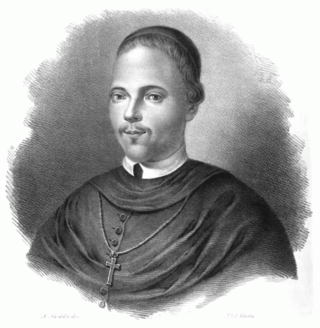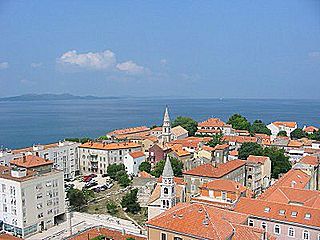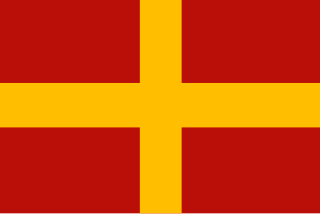
Dubrovnik, Italian: RagusaItalian:[raˈɡuːza] ; see notes on naming, is a city in southern Dalmatia, Croatia, by the Adriatic Sea. It is one of the most prominent tourist destinations in the Mediterranean, a seaport and the centre of the Dubrovnik-Neretva County. Its total population is 41,562. In 1979, the city of Dubrovnik was added to the UNESCO list of World Heritage Sites in recognition of its outstanding medieval architecture and fortified old town.
The History of Dalmatia concerns the history of the area that covers eastern coast of the Adriatic Sea and its inland regions, from the 2nd century BC up to the present day. The region was populated by Illyrian tribes around 1,000 B.C, including the Delmatae, who formed a kingdom and for whom the province is named. Later it was conquered by Rome, thus becoming the province of Dalmatia, part of the Roman Empire. Dalmatia was ravaged by barbaric tribes in the beginning of the 4th century.
Francesco Maria Appendini was an Italian Latin and Italian scholar who studied Slavic languages in the Republic of Ragusa. The French invasion prevented him from returning to Italy, and he adopted Republic of Ragusa as his own country. He took it upon himself to investigate its history and antiquities.

The Republic of Ragusa was an aristocratic maritime republic centered on the city of Dubrovnik in South Dalmatia that carried that name from 1358 until 1808. It reached its commercial peak in the 15th and the 16th centuries, before being conquered by Napoleon's French Empire and formally annexed by the Napoleonic Kingdom of Italy in 1808. It had a population of about 30,000 people, of whom 5,000 lived within the city walls. Its motto was "Non bene pro toto libertas venditur auro", a Latin phrase which can be translated as "Liberty is not well sold for all the gold".

Giorgio da Sebenico or Giorgio Orsini or Juraj Dalmatinac was a Venetian sculptor and architect from Dalmatia, who worked mainly in Sebenico, and in the city of Ancona, then a maritime republic.

Ignjat Đurđević, also known as Ignazio Giorgi was a Ragusan baroque poet and translator, best known for his long poem Uzdasi Mandaljene pokornice. He wrote poetry in Latin, Italian, and Croatian.
Rajmund Kunić or Raimondo Cunich was a Latin and Greek humanist from Dubrovnik, Republic of Ragusa.

Serafino Cerva, also known as Saro, was a Dalmatian Italian author of Ragusan Library, the first encyclopedia in the Dalmatian language, which comprised 435 biographies of ancient men and of the "Athens of the Adriatic" (Ragusa). He translated some minor local literary works into Italian. He belonged to the Cerva family.

Giovanni Bona de Boliris was an Italian humanist poet and writer, who wrote in Latin and Italian.

The House of Resti or Restić, was a Ragusan noble family. It was an old patrician family, originating in Dalmatia.

The maritime republics, also called merchant republics, were Italian thalassocratic port cities which, starting from the Middle Ages, enjoyed political autonomy and economic prosperity brought about by their maritime activities. The term, coined during the 19th century, generally refers to four Italian cities, whose coats of arms have been shown since 1947 on the flags of the Italian Navy and the Italian Merchant Navy: Amalfi, Genoa, Pisa, and Venice. In addition to the four best known cities, Ancona, Gaeta, Noli, and, in Dalmatia, Ragusa, are also considered maritime republics; in certain historical periods, they had no secondary importance compared to some of the better known cities.

Orsat "Medo" Pucić, was a Ragusan writer and an important member of the Serb-Catholic movement in Dubrovnik.

Dalmatian Italians are the historical Italian national minority living in the region of Dalmatia, now part of Croatia and Montenegro.

Venetian Albania was the official term for several possessions of the Republic of Venice in the southeastern Adriatic, encompassing coastal territories primarily in present-day southern Montenegro and partially in northern Albania.

The House of Bona, or Bunić, is a noble family long established in the city of Dubrovnik.

The House of Cerva or Crijević was a Ragusan noble family from Ragusa, which held noble titles in the Republic of Ragusa, and in the Austrian and Austro-Hungarian empires. Descendants of the family live in Austria and Italy.

Pier Alessandro Paravia was born in Zara, Dalmatia on July 15, 1797 and was a Dalmatian Italian writer, scholar, philanthropist and professor of Italian eloquence at the University of Turin.

The House of Bobali or Babalio was a noble family of the Republic of Ragusa.

The House of Buća was a noble Serbian family that served the Republic of Ragusa, and one of the most important families to come out of Kotor. A cadet branch was admitted to the nobility of the Republic of Ragusa, another branch moved instead to Šibenik.

The Republic of Ancona was a medieval commune and maritime republic notable for its economic development and maritime trade, particularly with the Byzantine Empire and Eastern Mediterranean, although somewhat confined by Venetian supremacy on the sea. It enjoyed excellent relations with the Kingdom of Hungary, was an ally of the Republic of Ragusa, and maintained good relations with the Ottoman Empire. All these relationships enabled it to serve as central Italy's gateway to the Orient.



























